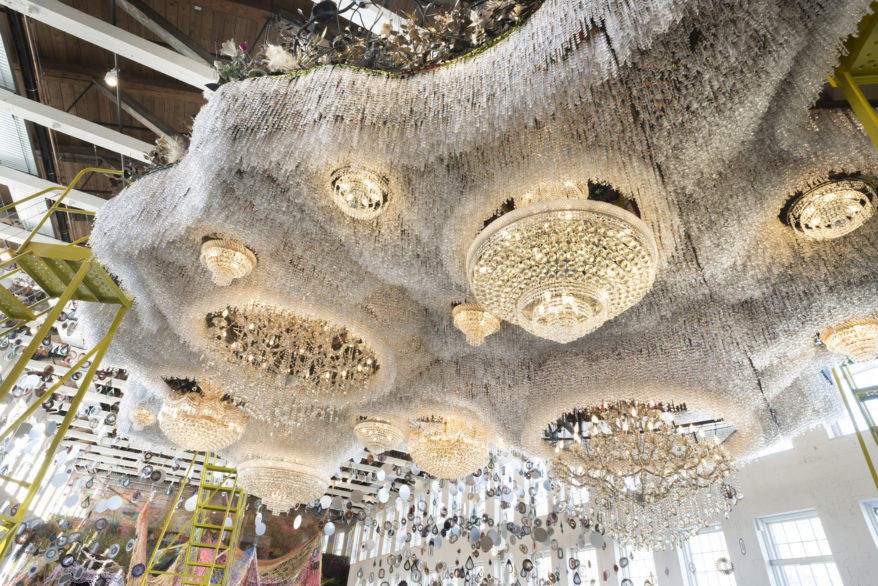Post by sɐǝpı ɟo uoıʇɐɹǝpǝɟ on Mar 20, 2017 0:23:27 GMT
(sorry not THAT Nick Cave)
massmoca.org/event/nick-cave-until/


If you think you know Nick Cave, think again. The artist celebrated for his wearable sculptures called Soundsuits turns expectations inside out at MASS MoCA in a massive immersive installation that opened on October 16, 2016, where not a single Soundsuit is found. Instead, Cave uses MASS MoCA’s signature football field-sized space to create his largest installation to date, made up of thousands of found objects and millions of beads, which will make viewers feel as if they have entered a rich sensory tapestry, like stepping directly inside the belly of one of his iconic Soundsuits.
Cave’s first Soundsuit, made out of twigs, was a direct response to the Rodney King beating, a visual image about social justice that was both brutal and empowering. Just as the violence around the Rodney King beating was the impetus to Cave’s early work, the death of men such as Eric Garner, Trayvon Martin, and Michael Brown drives his new imagery. For Cave’s MASS MoCA installation, Until — a play on the phrase “innocent until proven guilty,” or in this case “guilty until proven innocent” — he addresses issues of gun violence, gun control policy, race relations, and gender politics in America today.
Until begins with a dense sculptural field of metallic lawn ornaments leading to a crystal cloud topped by a private garden populated with birds, flowers, and black-face lawn jockeys, finally coming to rest before a cliff wall hand-woven with shoelaces and hundreds of thousands of colorful pony beads. This is an active space where alluring kinetics and a sumptuous, overwhelming materiality give way to stark images of guns, bullets, and targets, positioning us all as culpable, vulnerable, and potentially under attack. The aim of this is pointed, questioning us to spark discussion about important issues in a space that is at once dazzling, provocative, and — ultimately — optimistic. Cave believes in humanity, celebrating possibility while also creating a forum for critical discussion that eventually provokes the question, “Is there racism in heaven?”
Cave has come to see himself as a messenger, endeavoring to coalesce communities, discuss important issues, and ultimately heal through art. “I view this work as an elaborate community forum, as much as a work of sculpture,” notes Cave. As such, the gallery will double as a stage for internationally known dancers, singer-songwriters, pop artists, poets, and composers, together with panel discussions, community forums, and other forms of creative public debate and engagement. The inaugural performers — Brenda Wimberly, a soprano singer anchored in gospel music roots, and Sereca Henderson, a musicologist, singer, and organist who has played with Eric Clapton and B.B. King — will perform during the exhibition opening reception on October 15. On Friday, October 28, powerhouse vocalist Helga Davis responds to Until with an intimate concert in the exhibition, performed solo with backing loops. Iconic choreographer Bill T. Jones and powerful dancer Okwui Okpokwasili each respond

www.nytimes.com/2016/08/14/arts/design/the-artist-nick-cave-gets-personal-about-race-and-gun-violence.html?_r=1
massmoca.org/event/nick-cave-until/


If you think you know Nick Cave, think again. The artist celebrated for his wearable sculptures called Soundsuits turns expectations inside out at MASS MoCA in a massive immersive installation that opened on October 16, 2016, where not a single Soundsuit is found. Instead, Cave uses MASS MoCA’s signature football field-sized space to create his largest installation to date, made up of thousands of found objects and millions of beads, which will make viewers feel as if they have entered a rich sensory tapestry, like stepping directly inside the belly of one of his iconic Soundsuits.
Cave’s first Soundsuit, made out of twigs, was a direct response to the Rodney King beating, a visual image about social justice that was both brutal and empowering. Just as the violence around the Rodney King beating was the impetus to Cave’s early work, the death of men such as Eric Garner, Trayvon Martin, and Michael Brown drives his new imagery. For Cave’s MASS MoCA installation, Until — a play on the phrase “innocent until proven guilty,” or in this case “guilty until proven innocent” — he addresses issues of gun violence, gun control policy, race relations, and gender politics in America today.
Until begins with a dense sculptural field of metallic lawn ornaments leading to a crystal cloud topped by a private garden populated with birds, flowers, and black-face lawn jockeys, finally coming to rest before a cliff wall hand-woven with shoelaces and hundreds of thousands of colorful pony beads. This is an active space where alluring kinetics and a sumptuous, overwhelming materiality give way to stark images of guns, bullets, and targets, positioning us all as culpable, vulnerable, and potentially under attack. The aim of this is pointed, questioning us to spark discussion about important issues in a space that is at once dazzling, provocative, and — ultimately — optimistic. Cave believes in humanity, celebrating possibility while also creating a forum for critical discussion that eventually provokes the question, “Is there racism in heaven?”
Cave has come to see himself as a messenger, endeavoring to coalesce communities, discuss important issues, and ultimately heal through art. “I view this work as an elaborate community forum, as much as a work of sculpture,” notes Cave. As such, the gallery will double as a stage for internationally known dancers, singer-songwriters, pop artists, poets, and composers, together with panel discussions, community forums, and other forms of creative public debate and engagement. The inaugural performers — Brenda Wimberly, a soprano singer anchored in gospel music roots, and Sereca Henderson, a musicologist, singer, and organist who has played with Eric Clapton and B.B. King — will perform during the exhibition opening reception on October 15. On Friday, October 28, powerhouse vocalist Helga Davis responds to Until with an intimate concert in the exhibition, performed solo with backing loops. Iconic choreographer Bill T. Jones and powerful dancer Okwui Okpokwasili each respond

www.nytimes.com/2016/08/14/arts/design/the-artist-nick-cave-gets-personal-about-race-and-gun-violence.html?_r=1



